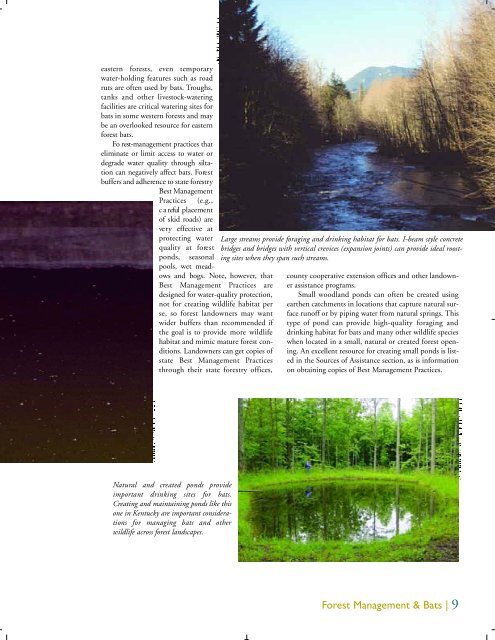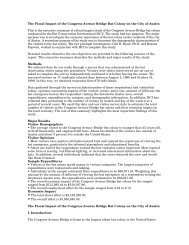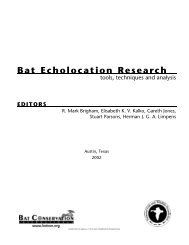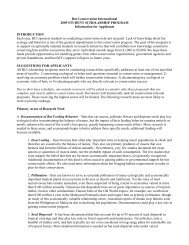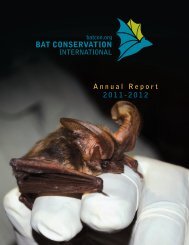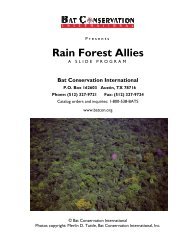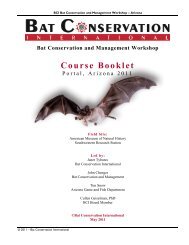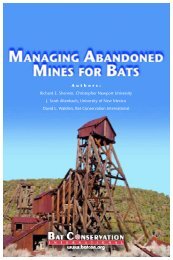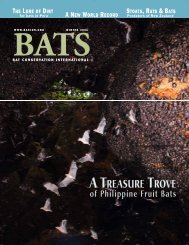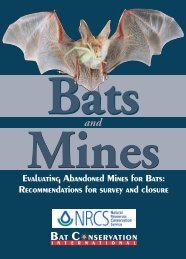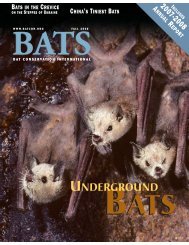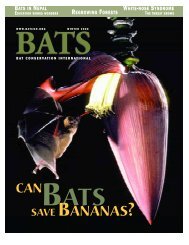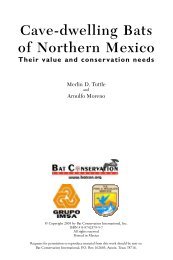Forest Management & Bats - Bat Conservation International
Forest Management & Bats - Bat Conservation International
Forest Management & Bats - Bat Conservation International
Create successful ePaper yourself
Turn your PDF publications into a flip-book with our unique Google optimized e-Paper software.
eastern forests, even temporary<br />
water-holding features such as road<br />
ruts are often used by bats. Troughs,<br />
tanks and other livestock-watering<br />
facilities are critical watering sites for<br />
bats in some western forests and may<br />
be an overlooked resource for eastern<br />
forest bats.<br />
Fo rest-management practices that<br />
eliminate or limit access to water or<br />
degrade water quality through siltation<br />
can negatively affect bats. Fo re s t<br />
buffers and adherence to state fore s t ry<br />
Best Ma n a g e m e n t<br />
Practices (e.g.,<br />
c a reful placement<br />
of skid roads) are<br />
ve ry effective at<br />
p rotecting water<br />
quality at fore s t<br />
ponds, seasonal<br />
pools, wet meadows<br />
and bogs. Note, however, that<br />
Best <strong>Management</strong> Practices are<br />
designed for water-quality protection,<br />
not for creating wildlife habitat per<br />
se, so forest landowners may want<br />
wider buffers than recommended if<br />
the goal is to provide more wildlife<br />
habitat and mimic mature forest conditions.<br />
Landowners can get copies of<br />
state Best <strong>Management</strong> Pr a c t i c e s<br />
through their state forestry offices,<br />
Large streams provide foraging and drinking habitat for bats. I-beam style concrete<br />
bridges and bridges with vertical crevices (expansion joints) can provide ideal roosting<br />
sites when they span such streams.<br />
county cooperative extension offices and other landowner<br />
assistance programs.<br />
Small woodland ponds can often be created using<br />
earthen catchments in locations that capture natural surface<br />
runoff or by piping water from natural springs. This<br />
type of pond can provide high-quality foraging and<br />
drinking habitat for bats and many other wildlife species<br />
when located in a small, natural or created forest opening.<br />
An excellent resource for creating small ponds is listed<br />
in the Sources of Assistance section, as is information<br />
on obtaining copies of Best <strong>Management</strong> Practices.<br />
Na t u ral and created ponds prov i d e<br />
i m p o rtant drinking sites for bats.<br />
Creating and maintaining ponds like this<br />
one in Kentucky are important considerations<br />
for managing bats and other<br />
wildlife across forest landscapes.<br />
<strong>Forest</strong> <strong>Management</strong> & <strong><strong>Bat</strong>s</strong> | 9


